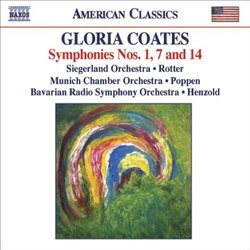| All Artists: Gloria Coates, Brs, Henzold Title: Gloria Coates: Symphonies Nos. 1, 7 & 14 Members Wishing: 1 Total Copies: 0 Label: Naxos American Original Release Date: 1/1/2006 Re-Release Date: 4/18/2006 Genre: Classical Styles: Historical Periods, Modern, 20th, & 21st Century, Symphonies Number of Discs: 1 SwapaCD Credits: 1 UPC: 636943928929 |
Search - Gloria Coates, Brs, Henzold :: Gloria Coates: Symphonies Nos. 1, 7 & 14
 | Gloria Coates, Brs, Henzold Gloria Coates: Symphonies Nos. 1, 7 & 14 Genre: Classical
|
Larger Image |
CD DetailsSimilar CDs
|
CD ReviewsUnique, intense, but terribly testing mianfei | 12/10/2007 (5 out of 5 stars) "Having adored Sofia Gubaidulina's In Croce and having been recommended Gloria Coates by "avant-captain nemo", Gloria Coates' symphonies were a natural listen for me. Though Coates' symphonies (some of which were composed before "In croce") are less dense than Gubaidulina's, there is a very definite similarity in the work of the two composers because both rely on intense, passionately-played melodies on strings tuned in unusual ways. Though seldom noticed, this is quite like the melodies bands like My Bloody Valentine and the lesser-known Band of Susans did with electric guitars. On "Symphonies Nos. 1, 7 & 14", apart from a timpani at the end of one track and a full orchestra on "Symphony No.7", the sound is exclusively based around string orchestras that superficially can seem to be just playing the same note repeatedly. [My mother once compared it to a malfunctioning electrical appliance!] Nonetheless, careful listening does reveal a great deal going on as the strings move through each of the symphonies here. The energy, though held remarkably deep, is particularly pronounced in "Lamentation", which possesses remarkable turbulence behind its apparent "nothingness", but is present all through the three symphonies present here and makes them a remarkably consistent listen. "Whirligig of Time" really does whirl in a remarkable way, aided by some powerful brass work, and there is a degree of variation in the sound that seems quite unexpected from a superficial listen. If you listen many times (with decent headphones) you will see how clearly the deep emotion is let out at the finale of every piece in a way that is almost electrifying. Coates is certainly an acquired taste, but for intense, extended string drones nothing surpasses this set of symphonies. As the liner notes say, it sounds as if you are swept away slowly but without any chance of escaping." Gloria Coates Symphonies on Naxos Robin Friedman | Washington, D.C. United States | 12/11/2007 (4 out of 5 stars) "It is always an adventure to discover the work of an unfamiliar composer. One of the best sources for the discovery of new music is the budget-priced Naxos label's "American Classics" series. I was pleased to hear symphonies by Gloria Coates (b. 1938), a composer I had not known before.
Coates has lived in Germany since 1969, and her work is not well-known. It is challenging, difficult, and discordant music which will not appeal to everyone. But I found it moving and fascinating. The most prominent feature of Coates's music is the use of string glissandos -- slidings up and down the scale as occur when one runs one's fingers over the piano. The glissandos at various volumes tempos, rhythms, and registers are ever-present, sometimes as the theme and sometimes as background. Other features of this music include the use of counterpoint, canonical writing with much repetition and variation. The music uses a hypnotic rhythm, frequently punctuated with tympani or other percussion. And the music is discordant, using quarter tones, atonality, pentatonic scales, and instruments playing in different scales. Coates's symphonies are programmatic as the composer gives descriptive titles to each movement, sometimes after the fact. This CD includes three symphonies by Gloria Coates (she has composed 15) written at different stages of her career. The symphonies are performed by three different orchestras, and recorded at different times, which makes this CD an excellent overview of Coates's work and of performance practices. The earliest work on this CD is Coates's symphony no. 1, "Music on Open Strings", a short four-movement work composed in 1972-1973. The recording dates from 1980 and features the Siegerland Orchestra. The work is scored for strings and tympani. This work requires special tuning for the orchestra, as the initial movements are played on open strings (with the exception of the glissandos) tuned to the pentatonic scale (equivalent to the five black keys on the piano). In the third movement, the orchestra gradually retunes to the diatonic scale. There is one of Haydn's symphonies in which, as a joke, Haydn has the orchestra retune midway through a movement. But Coates music is highly serious. This short work is perhaps Coates at her most accessible. Coates Symphony No. 7 is a lengthy, complex three-movement work that dates from 1990 and is "dedicated to those who brought down The Wall in PEACE." It is performed by the Barvarian Radio Symphony Orchestra in a recording that dates from 1997. The three movement in the work commemorate in various ways the passage of time. The movements involve repetitions of highly rhythmic themes and glissandos which work inexorably to large climactic moments of great intensity and rigor. The final work on this CD is Coates's three movement Symphony No. 14, the "Symphony in Microtones" composed in 2001-2002. The work was recorded in 2003 by the Munich Chamber Orchestra. This is Coates's most American symphony, as the first two movements incorporate music of two early American composers, Supply Belcher (1750 -- 1836) and William Billings (1746- 1800). The third movement is a tribute to Coates's teacher, Otto Luening (1990 -- 1996). In this work the orchestra plays in two sections, a quarter-tone apart, resulting in great discordancy. Hymnal and melodic material arises, mid to end of each movement, from the discordancy and swirling glissandos and then fade away. Charles Ives, of course, was the great American composer who used quarter-tones, discordancy, and the incorporation of hymns and popular material to large effect in his music. Coates's use of these techniques is chisled and austure, in contrast to Ives's overflowing optimism and verve. Coates's work probably is not a good choice for newcomers to American music or for those with exclusively conservative tastes. From this CD, she seems to work within a rather narrow range of musical voice and technique. For those who want to explore modernistic American music somewhat off the beaten track, this may be a rewarding CD. Robin Friedman" |

 Track Listings (10) - Disc #1
Track Listings (10) - Disc #1

